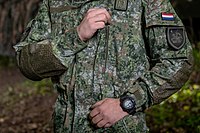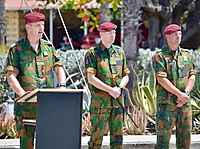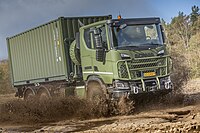Royal Netherlands Army
| Royal Netherlands Army | |
|---|---|
| Koninklijke Landmacht | |
Utrecht | |
| Engagements | List of engagements
|
| Commanders | |
Lt Gen Martin Wijnen[2] | |
| Deputy commander | Maj Gen Rob Jeulink |
| Army Adjutant | WO Ad Koevoets[3] |
| Insignia | |
| Flag | 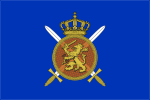 |
| Flag used on government buildings | 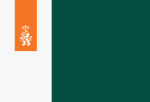 |
| Logo |  |
The Royal Netherlands Army (
Since 1990, the army has been sent into the
The tasks of the Royal Netherlands Army are laid out in the
Dutch army doctrine strongly emphasises international co-operation.[8] The Netherlands are a founding member of, and strong contributor to NATO, while closely co-operating with fellow member states during European Union-led missions as well. Moreover, the successful Dutch-German military co-operation is seen as a harbinger of European defence integration, facing fewer linguistic and cultural issues than the comparable Franco-German Brigade.[9] In 2014, the 11 Airmobile Brigade was integrated into the Rapid Forces Division;[10] in 2016, the Dutch-German 414 Tank Battalion was integrated into the 43rd Mechanised Brigade, which was in turn integrated into the 1st Panzer Division.[9][11] In 2023, the final brigade of the Royal Netherlands Army, the 13th Light Brigade, was integrated into the 10th Panzer Division of the German Bundeswehr.[12][13]
Additionally, the German Air Defence Missile Group 61 (German: Flugabwehrraketengruppe 61) was integrated into the Dutch Joint Ground-based Air Defence Command in 2018.[14]
History
Origins
The Royal Netherlands Army was raised on 9 January 1814, but its origins date back to the founding of the Staatse Leger (the Army of the Dutch States) in 1572: the creation of one of the first modern standing armies. Under the command of famous commanders such as Maurice of Orange and William Louis of Nassau-Dillenburg, the army developed into one of the best-organised and best-trained armies of the 17th and early 18th centuries.[15][4] The innovative army underwent a thorough process of professionalisation under their command including revolutionary foot drill and siege tactics, proven effective during sieges such as the Battle of Nieuwpoort.[16][17]
The
French period (1795–1814)
With the French conquest of the Netherlands, the Staatse Leger was replaced by the army of the

Kingdom of the Netherlands (1814–1914)
In 1814, a year after the return of
During the
World wars (1914–1945)
The Netherlands continued the policy of
At the beginning of the
The Royal Netherlands army was disbanded during the German occupation, however army personnel continued the battle against the German occupiers during the war. Army resistance began to rise again with the formation of the
Decolonisation and Cold War (1945–1991)
Dutch East Indies
Between 1945 and 1949, the Royal Netherlands Army, which originally used mainly
Cold War
During the Korean War, 4,748 members of the army, the Royal Netherlands Navy and the Netherlands Marine Corps formed the Nederlands Detachement Verenigde Naties and were dispatched to East Asia to fight against the troops of the People's Republic of China and North Korea. 122 soldiers were killed in action, 3 soldiers went missing in action.[32]
The
- Assume responsibility for its corps sector and relieve 1st German Corps forces as soon as possible.
- Fight the covering force battle in accordance with COMNORTHAG's concept of operations.
- In the main defensive battle: (1) hold and destroy the forces of the enemy's leading armies conventionally as far east as possible, maintaining cohesion with 1 (GE) Corps; (2) in the event of a major penetration affecting 1 (NL) Corps sector, be prepared to hold the area between the roads A7 and B3 and to conduct a counterattack according to COMNORTHAG's concept of operations.
- Maintain cohesion with LANDJUT and secure NORTHAG's left flank in the Forward Combat Zone.
Dutch army troops have deployed to Lebanon as part of an international protection force since 1979 War in Lebanon, 1979–1985
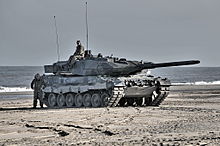
Recent history (1991–present)
The
As mentioned,
Bosnia
Dutch army personnel was deployed to
Iraq
A contingent of 1,345 troops (comprising Army and
From 2015 until the spring of 2018, Dutch
Afghanistan
Between 2001 and 2003, a reinforced army company was deployed to Afghanistan to provide support in maintaining public order, and providing security in and around the capital
Between 2006 and 2010, the Netherlands deployed personnel to southern Afghanistan.
Since 2015, 160 Dutch troops from the
Mali
Special forces of the Korps Commandotroepen have been deployed to Mali since 2014 as part of the UN-mission MINUSMA.[67] The primary task of the Dutch forces has been to gather intelligence concerning local Islamist groups and to protect the people of Mali against radical Islamist groups.[68] Since 2016, personnel of 11th Airmobile Brigade and 13th Light Brigade have been included in rotations. On 6 July 2016, two servicemen of 11 Airmobile Brigade were killed during a mortar firing exercise, a third serviceman was severely wounded.[69] The incident lead to the resignation of the minister of Defence Jeanine Hennis-Plasschaert and Chief of Defence Tom Middendorp after a critical report by the Dutch Safety Board found that the safety-standards were subpar.[70][71] The Netherlands have ended their troop contribution to the peacekeeping mission in May 2019 to send troops to Afghanistan instead.[72]
Lithuania
The
Structure
The core fighting element of the army consists of three brigades: 11 Airmobile Brigade, 13 Light Brigade and 43 Mechanised Brigade.[77] The number of full-time professional personnel is 22,850, in addition to around 4,000 reservists.[1] The Royal Netherlands Army is a volunteer force; compulsory military service has not been abolished but has been suspended.[78] The other three services, (the Royal Netherlands Navy, Royal Netherlands Air Force and Royal Marechaussee), are fully volunteer forces as well.
- Utrecht
- Schaarsbergen
 13 Light Brigade, in Oirschot
13 Light Brigade, in Oirschot 43 Mechanised Brigade, in Havelte
43 Mechanised Brigade, in Havelte Korps Commandotroepen, in Roosendaal
Korps Commandotroepen, in Roosendaal- 1 (GE/NL) Corps, in Münster(Germany)
 Joint Ground-based Air Defence Command, in Vredepeel
Joint Ground-based Air Defence Command, in Vredepeel Operational Support Command Land, in Apeldoorn
Operational Support Command Land, in Apeldoorn Army Materiel Logistic Command, in Utrecht
Army Materiel Logistic Command, in Utrecht Education and Training Command, in Amersfoort
Education and Training Command, in Amersfoort
Traditions
Besides the hierarchical organisation, the Royal Netherlands Army upholds a traditional organisation in which a distinction exists between arms of services. This organisation is purely ceremonial. Generally speaking, combat and combat support units are organised in arms, and support units are organised in services.[79] There are two exceptions: the Engineers and the Signals Service.
The arms and services can in turn be further divided into one, or multiple regiments. These administrative organisations safeguard the traditions of the operational units. Before the
Arms
The Royal Netherlands Army consists of the following arms, and subsequent regiments and corps:[79]
| Regiment | Unit | Year | Insignia | Notes | ||
|---|---|---|---|---|---|---|
| Infantry Arm (Foot guards) | ||||||
Garderegiment Grenadiers en Jagers |
11 Infantry Battalion | 1995 |   |
Established in 1995 through amalgamation of two regiments which were formed in 1829. | ||
| Garderegiment Fuseliers Prinses Irene | 17 Armoured Infantry Battalion | 1941 |  |
Established in 1941. | ||
| Infantry Arm (Line infantry) | ||||||
| Regiment Infanterie Johan Willem Friso | 44 Armoured Infantry Battalion | 1813 |  |
Former 1st and 9th Infantry Regiment, established in 1813. | ||
| Regiment Infanterie Oranje Gelderland | 45 Armoured Infantry Battalion | 1813 |  |
Former 5th and 8th Infantry Regiment, established in 1813. | ||
| Regiment Limburgse Jagers | 42 Armoured Infantry Battalion | 1813 | 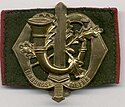 |
Former 2nd, 6th and 11th Infantry Regiment, established in 1813. | ||
Regiment Van Heutsz |
12 Infantry Battalion | 1832 |  |
Maintains traditions of the disbanded Royal Netherlands East Indies Army and the Netherlands Detachment United Nations which fought in the Korean War, established in 1832 although origins date back to 1814. | ||
Korps Nationale Reserve |
• 10 National Reserve Battalion • 20 National Reserve Battalion • 30 National Reserve Battalion |
1914 |  |
Maintains traditions of the Volunteer Landstorm, established in 1914. | ||
| Korps Commandotroepen | Korps Commandotroepen | 1942 | 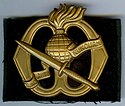 |
Successor to No. 2 (Dutch) Troop and Korps Speciale Troepen, established in 1942. | ||
| Regiment Stoottroepen Prins Bernhard | 13 Infantry Battalion | 1944 |  |
Established in 1944 by amalgation of several resistance groups. | ||
| Regiment Infanterie Menno van Coehoorn | Disbanded | 1950 |  |
Former 3rd Infantry Regiment, disbanded in 1997. | ||
| Regiment Infanterie Chassé | Disbanded | 1950 |  |
Former 7th and 10th Infantry Regiment, disbanded in 1995. | ||
| Cavalry Arm | ||||||
Regiment Huzaren Van Boreel |
• 11 Brigade Reconnaissance Squadron • 42 Brigade Reconnaissance Squadron • 43 Brigade Reconnaissance Squadron • 104 JISTARC Reconnaissance Squadron |
1813 |  |
Former 4th Hussars Regiment. Established in 1813 while its origins date back to 1585. – Reconnaissance/ISTAR | ||
| Regiment Huzaren Prins Alexander | Disbanded | 1950 |  |
Former 3rd Hussar Regiment, the regiment was disbanded in November 2007. The maintenance of regimental traditions was transferred to the Regiment Huzaren van Boreel. The regiment was permanently disbanded by royal decree on 2 June 2016. | ||
Regiment Huzaren Van Sytzama |
Disbanded | 1951 |  |
Former 1st Hussar Regiment, disbanded in May 2011. The maintenance of regimental traditions was transferred to the Regiment Huzaren van Boreel. The regiment was formally re-established by royal decree on 2 June 2016. Disbanded 2020. | ||
| Regiment Huzaren Prins van Oranje | Disbanded | 1979 |  |
Former 2nd Hussar Regiment, disbanded in September 2012. The maintenance of regimental traditions was transferred to the Regiment Huzaren van Boreel. The regiment was formally re-established by royal decree on 2 June 2016. Disbanded 2020 | ||
| Regiment Huzaren Prinses Catharina-Amalia | 4th Tank Company, 414 Tank Battalion | 2020 |  |
The regiment was formally established by royal decree on 20 November 2020. At the same time Regiment Huzaren Prins Alexander, Regiment Huzaren Van Sytzama and Regiment Huzaren Prins van Oranje have been disbanded. | ||
| Artillery Arm | ||||||
| Korps Veldartillerie | • A Battery of 41 Artillery Battalion • B Battery of 41 Artillery Battalion • D Battery of 41 Artillery Battalion |
1677 |  |
self-propelled howitzers .
| ||
| Korps Rijdende Artillerie | • Staff Battery of 41 Artillery Battalion • C Battery of 41 Artillery Battalion |
1793 |  |
Horse artillery corps, established in 1793. Currently operates 120mm Rayé Tracté heavy mortars. | ||
| Korps Luchtdoelartillerie | 13th Air Defense Battery | 1917 |  |
, and TRML systems. | ||
| Engineer Arm | ||||||
| Regiment Genietroepen | • 11 Engineer Company • 41 Armoured Engineer Battalion • 11 Armoured Engineer Battalion • 101 Engineer Battalion |
1748 |  |
Established in 1748. | ||
| Signals Arm | ||||||
| Regiment Verbindingstroepen | • Command & Control Support Command • 102 Electronic Warfare Company |
1874 |  |
Established in 1874. | ||
| Information Manoeuvre Arm | ||||||
| Korps Inlichtingen & Veiligheid Prinses Alexia | • Joint ISTAR Command • Defense Intelligence and Security Institute |
2020 |  |
Established in 2020. Successor of 101 MI Coy (est. 1954). | ||
| Korps Communicatie & Engagement Prinses Ariane | • 1 CMI Command |
2020 |  |
Established in 2020. | ||
Infantry
Each infantry regiment of the Royal Netherlands Army consists of a single battalion. The current order of battle includes a total of seven infantry battalions – of these, two are classed as foot guards and the remainder as line infantry.[81]
The staff support companies of
Cavalry
The cavalry arm currently consists of two active regiments – the Regiment Huzaren van Boreel and the Regiment Huzaren Prinses Catharina-Amalia. One has responsibility for the army's active reconnaissance units, while the other has been formed as the parent regiment for units equipped with main battle tanks (MBTs).
Prior to 2012, the army also included full armoured regiments equipped with MBTs. One of these, the
In 2016, a
Services
The services (Dienstvakken) consist of the logistical service, which comprises four regiments, and four stand-alone support services. The Royal Netherlands Army consists of the following services and regiments:[79]
Uniforms
The Royal Netherlands Army uniform has multiple categories, ranging from ceremonial uniforms to combat dress to evening wear. In addition, the (special) service dress uniform and mess dress uniform can both be worn in a tropics colourway.[84]
There are four main uniform categories:
- Combat uniform
The
- Woodland: Further developed version of the British Disruptive Pattern Material (DPM) camouflage pattern. Optimised for use in wooded terrain in Western Europe and the standard pattern for personnel in the Netherlands.
- Desert: Increasing amount of deployments in desert like environments, such as Iraq and Afghanistan, lead to the implementation of the Desert combat uniform. The desert combat uniform uses the regular combat uniform, while using the American Desert Camouflage Pattern.
- Jungle: The jungle combat uniform utilises the regular combat uniform, in a five-coloured camouflage pattern which is optimised for deployments in tropical environments. The jungle uniform is often used by personnel undergoing jungle training, and units stationed in the Dutch Caribbean.
- MultiCam: Since the regular combat uniform no longer always qualifies for contemporary operations, personnel deploying to foreign countries is provided with interim combat uniforms in the MultiCam camouflage pattern.[85] In addition, the Korps Commandotroepen has implemented uniforms in MultiCam as their standard uniform since 2017.[86] Regular units use the interim uniforms until combat clothing in the newly developed Netherlands Fractal Pattern is distributed, between 2020 and 2022.
- Service dress uniform
The
- Mess dress uniform
The
- Full dress uniform
Each regiment and corps within the army has its own full dress uniform (Ceremonieel tenue, CT), which is a traditional uniform that is worn during ceremonies and special occasions.
-
Soldier wearing the Field Artillery Corps ceremonial uniform during the firing of salute shots on Prinsjesdag.
-
Hussar of 414 Tank Battalion wearing a tank overall in the new Netherlands Fractal Pattern.
-
Jungle combat uniform worn by 11 Airmobile Brigade servicemen as part of the contingent in the Dutch Caribbean.
-
Standard combat uniform in the Disruptive Pattern Material camouflage pattern.
-
Knights of theMilitary William Order Kenneth Mayhew, Major Marco Kroon and Lieutenant Colonel Gijs Tuinman, the last both wearing the special dress uniform.
Military bands

In past eras, music was used as a means of communication on the battlefield, and today
- Royal Military Band "Johan Willem Friso"
- National Reserve Corps Fanfare Brass
- Regimental Fanfare Orchestra of the Grenadiers' and Rifles' Guards
- Fanfare Orchestra "Bereden Wapens" of the RNA Cavalry
Colours and standards
All regiments and corps are granted a colour (vaandel) or standard (standaard), including (since 2002) the artillery corps, which at the time was a breach with tradition. The colours and standards form the embodiment of the history and character of the respective regiment or corps. The standards are smaller in size because of a historical reason: horseback units would often struggle with the large sized poles of the regular colours, and therefore chose to wield a shorter version. To this day, the mounted units of the Royal Netherland Army, such as cavalry, field artillery and horse artillery, use the smaller sized standards. The Royal Marechaussee, which used to be a mounted unit of the Royal Netherlands Army, owns a standard as well.[88]
In contrast to the functional use of colours and standards in the past, during which they served as landmarks on the battlefield, their contemporary role has been greatly reduced. Nonetheless, they continue to play an important role during various military ceremonies. For example, soldiers swear the oath of enlistment while holding the respective colour or standard. Moreover, the colours and standards constitute an important connection between military units and the
Ranks and insignia
The ranks of the Royal Netherlands were established by royal decree of
Commissioned officer ranks
The rank insignia of
| NATO code | OF-10 | OF-9 | OF-8 | OF-7 | OF-6 | OF-5 | OF-4 | OF-3 | OF-2 | OF-1 | OF(D) | Student officer | ||||||||||||||||||||||||
|---|---|---|---|---|---|---|---|---|---|---|---|---|---|---|---|---|---|---|---|---|---|---|---|---|---|---|---|---|---|---|---|---|---|---|---|---|

|

|

|

|

|

|

|

|

|

|
|||||||||||||||||||||||||||
Generaal
|
Luitenant-generaal | Generaal-majoor | Brigadegeneraal | Kolonel | Luitenant-kolonel | Majoor | Ritmeester
|
Eerste luitenant | Tweede luitenant | |||||||||||||||||||||||||||
Other ranks
The rank insignia of non-commissioned officers and enlisted personnel.
| NATO rank scale | OR-9 | OR-8 | OR-7 | OR-6 | OR-5 | OR-4 | OR-3 | OR-2 | OR-1 | |||||||||||||||||||||||||||
|---|---|---|---|---|---|---|---|---|---|---|---|---|---|---|---|---|---|---|---|---|---|---|---|---|---|---|---|---|---|---|---|---|---|---|---|---|
 |

|

|

|

|

|

|

|

| ||||||||||||||||||||||||||||
| Adjudant-onderofficier | Sergeant-majoor/ Opperwachtmeester |
Sergeant der 1e klasse/ Wachtmeester der 1e klasse |
Sergeant/ Wachtmeester |
Korporaal der 1e klasse | Korporaal | Soldaat/ Huzaar/ Kanonier der 1e klasse |
Soldaat/ Huzaar/ Kanonier der 2e klasse |
Soldaat/ Huzaar/ Kanonier der 3e klasse | ||||||||||||||||||||||||||||
Equipment
Infantry
The Royal Netherlands Army's basic weapon is the
Sniper groups (Schutter Lange Afstand) are equipped with
Armor
The army's
Artillery and air defence
The
(Protected) mobility
For environments that require protection against
Engineers and utility
Engineer regiments employ several specialist engineering vehicles based on
Unmanned vehicles
Multiple types of
-
Defenture VECTOR
-
Colt C8NLD
See also
- Military ranks of the Dutch armed forces
References
- ^ a b "Personnel Figures". defensie.nl. Ministry of Defence. 1 July 2021. Retrieved 9 February 2022.
- ^ Kos, Jelmer (2 April 2019). "Martin Wijnen wordt nieuwe commandant landstrijdkrachten". NRC Handelsblad. Retrieved 16 May 2020.
- ^ van Elk, Bert (3 March 2020). "Ervaren korporaals stromen door: Onderofficiersbestand aan het Infuus". Landmacht. 02. Retrieved 16 May 2020.
- ^ a b c Kamphuis, P.H.; Schoenmaker, B. (2014). "200 jaar Koninklijke Landmacht: Van blooded tot blooded" (PDF). Militaire Spectator. 183 (4). Retrieved 6 May 2020.
- ^ a b "Missie-overzicht". www.defensie.nl. Ministerie van Defensie. 28 August 2013. Retrieved 16 May 2020.
- ^ "Taken van de krijgsmacht". www.rijksoverheid.nl. Rijksoverheid. 23 April 2014. Retrieved 16 May 2020.
- ^ "11a. Integriteit". Algemeen militair ambtenarenreglement. Overheid.nl. 25 February 1982. Retrieved 16 May 2020.
Ik zweer trouw aan de Koning, gehoorzaamheid aan de wetten en onderwerping aan de krijgstucht. Zo waarlijk helpe mij God Almachtig
- ^ "Taken landmacht". www.defensie.nl. Ministerie van Defensie. 16 September 2019. Retrieved 16 May 2020.
- ^ a b Bennhold, Katrin (20 February 2019). "A European Army? The Germans and Dutch Take a Small Step". The New York Times. Retrieved 16 May 2020.
- ^ "Division Schnelle Kräfte". www.defensie.nl. Ministerie van Defensie. 12 December 2016. Retrieved 16 May 2020.
- ^ Hoffmann, Lars (8 August 2017). "German Armed Forces To Integrate Sea Battalion Into Dutch Navy". defensenews.com. Retrieved 1 October 2017.
- ^ Darroch, Gordon (1 February 2023). "Netherlands to integrate last brigade into German army this year: NRC". DutchNews.nl. Retrieved 28 March 2023.
- ^ NACHRICHTEN, n-tv. "Heer von Deutschland und Niederlanden nimmt Form an". n-tv.de (in German). Retrieved 28 March 2023.
- ^ "Duitse luchtverdedigingseenheid onder Nederlands bevel geplaatst". NU.nl. 4 April 2018. Retrieved 16 May 2020.
- ^ ISBN 9789068810202.
- ISBN 9781843835752.
- ^ Deen, Femke (January 2006). "De professionalisering van het leger tijdens de Tachtigjarige Oorlog: 'De discipline was zo strikt als in een klooster'". Historisch Nieuwsblad. Retrieved 6 May 2020.
- ISBN 9789071957475.
- ISBN 9789058756985.
- ^ Hay, Mark Edward (December 2013). "The Dutch Experience and Memory of the Campaign of 1812: a Final Feat of Arms of the Dutch Imperial Contingent, or: the Resurrection of an Independent Dutch Armed Forces?". Napoleonic Scholarship Journal. Retrieved 1 October 2017.
- ^ Snapper, F. (1972). "De legervorming in Nederland tussen 1813 en 1940" (PDF). Militaire Spectator. 01. Retrieved 17 May 2020.
- ^ "Geschiedenis landmacht". www.defensie.nl. Ministerie van Defensie. 16 September 2019. Retrieved 17 May 2020.
- ISBN 9022838684.
- ^ "1914–1940: Nederland neutraal". Ministerie van Defensie. 7 June 2017. Retrieved 17 May 2020.
- ISBN 9789461057020.
- ^ de Jong, Loe (1970). Het Koninkrijk der Nederlanden in de Tweede Wereldoorlog: 1939–1945 (Deel 3: Mei '40 ed.). 's-Gravenhage: Rijksinstituut voor Oorlogsdocumentatie.
- ^ "Oprichting". www.defensie.nl. Ministerie van Defensie. December 2017. Retrieved 17 May 2020.
- ^ "No.2 (Dutch) Troop". www.defensie.nl. Ministerie van Defensie. December 2017. Retrieved 17 May 2020.
- ISBN 978-0-7106-0341-8.
- ^ "1945–1949: Van Nederlands-Indië naar Indonesië". www.defensie.nl. Ministerie van Defensie. 7 June 2017. Retrieved 17 May 2020.
- ^ Harinck, Christiaan (26 July 2017). "Wie telt de Indonesische doden?". De Groene Amsterdammer. Retrieved 17 May 2020.
- ISBN 9012109159.
- ^ Structural details in 1985 can be seen at http://www.orbat85.nl/, accessed April 2012.
- ^ a-d quoted from Felius, Einde oefening. Infanterist tijdens de Koude Oorlog (Arnhem: Uitgeverij Quintijn, 2002), 305, via Hans Boersma, I (NL) Corps, accessed 4 April 2012
- ^ "United Nations Interim Force in Lebanon (UNIFIL)". www.defensie.nl. Nederlands Instituut voor Militaire Historie. 25 May 2010. Retrieved 5 May 2020.
- ISBN 9012106699.
- ^ Seegers, Jules (19 December 2013). "Leopard-tanks toch verkocht, Defensie vindt in Finland alsnog koper". NRC Handelsblad. Retrieved 5 May 2020.
- ^ "Verjaard materieel Defensie blijkt onverkoopbaar". De Volkskrant. 23 October 1998. Retrieved 5 May 2020.
- ^ "Defensie hard getroffen door bezuinigingen (Video) | Ministerie van Defensie". Archived from the original on 7 August 2011. Retrieved 26 April 2011.
- ^ dvhn.nl Archived 28 September 2011 at the Wayback Machine (in Dutch)
- ^ Niewold, Michaël (28 May 2015). "Zo slecht is ons legermaterieel". RTL Z. Retrieved 5 May 2020.
- ^ "Defensie-uitgaven verder afgenomen". www.cbs.nl. Centraal Bureau voor de Statistiek. 11 September 2015. Retrieved 5 May 2020.
- ^ Walenkamp, Keetje (23 January 2017). "Een strijd om de defensiebegroting". Militaire Spectator. Retrieved 5 May 2020.
- ^ "United Nations Protection Force (UNPROFOR) en de United Nations Peace Forces (UNPF)". www.defensie.nl. Nederlands Instituur voor Militaire historie. 15 April 2010. Retrieved 5 May 2020.
- ISBN 9789072047540.
- ^ Bowcott, Owen; Borger, Julian (22 November 2017). "Ratko Mladić convicted of war crimes and genocide at UN tribunal". The Guardian. Retrieved 5 May 2020.
- ^ "Srebrenica – Reconstruction, background, consequences and analyses of the fall of a 'safe' area" (PDF). NIOD Institute for War-, Holocaust- and Genocide Studies. 2002. Retrieved 5 May 2020.
- ^ "Nederlands aandeel inzet Irak". www.defensie.nl. Ministerie van Defensie. 21 August 2018. Retrieved 5 May 2020.
- ^ a b "Inzet in Irak" (PDF). www.defensie.nl. Nederlands Instituut voor Militaire Historie. Retrieved 5 May 2020.
- ^ "Nederlandse missie in Irak officieel geëindigd". De Volkskrant. ANP. 7 March 2005. Retrieved 5 May 2020.
- ^ "Nederland wil samen met België IS bekampen achter front in Irak". Gazet van Antwerpen. 9 September 2016. Retrieved 5 May 2020.
- ^ van Langendonck, Gert (17 July 2017). "Instructeurs leren geharde peshmerga beter schieten". NRC Handelsblad. Retrieved 5 May 2020.
- ^ "Militaire bijdrage Nederland in Irak". www.defensie.nl. Ministerie van Defensie. Retrieved 5 May 2020.
- ^ "De opbouw van ISAF in Afghanistan sinds 2001". Het Parool. 30 July 2010. Retrieved 5 May 2020.
- ^ a b "Eindevaluatie Nederlandse bijdrage aan ISAF, 2006 – 2010". www.tweedekamer.nl. Cabinet of the Netherlands. 28 September 2011. Retrieved 5 May 2020.
- ^ Dimitriu, G.R.; Tuinman, G.P.; van der Vorm, M. (2012). "Operationele ontwikkeling van de Nederlandse Special Operations Forces, 2005–2010" (PDF). 108 (3). Retrieved 5 May 2020.
{{cite journal}}: Cite journal requires|journal=(help) - ^ Derksen, Sebastiaan. "De Nederlandse missie in Uruzgan: 'COIN gekortwiekt?'" (PDF). Universiteit Leiden. Retrieved 5 May 2020.
{{cite journal}}: Cite journal requires|journal=(help) - ^ Elsevier. 1. Retrieved 5 May 2020.
- ^ "Nederlanders vochten mee in operatie Medusa". De Volkskrant. ANP. 15 September 2006. Retrieved 5 May 2020.
- ^ "Son of Top Dutch General Is Killed in Afghanistan". The New York Times. Associated Press. 19 April 2008. Retrieved 5 May 2020.
- ^ "ISAF Key Fact and Figures Placemat" (PDF). www.nato.int. NATO. 1 September 2008. Retrieved 5 May 2020.
- ^ "Afghanistan". www.nlveteraneninstituut.nl. Nederlands Veteraneninstituut (NLVi). 2 October 2014. Retrieved 14 January 2022.
- ^ "Einde missie Uruzgan: kleine ceremonie". De Volkskrant. ANP. 30 July 2010. Retrieved 5 May 2020.
- ^ "Nederlandse bijdrage Resolute Support". www.defensie.nl. Ministerie van Defensie. 11 December 2018. Retrieved 5 May 2020.
- ^ Brasser, Bianca (7 May 2019). "KCT mee met Afghanen: Shana ba shana". Landmacht. 04. Retrieved 5 May 2020.
- ^ "Nederlandse commando's in heel Afghanistan". De Telegraaf. 24 May 2019. Retrieved 5 May 2020.
- ^ de Ridder, Marlous (10 June 2014). "Commando's welkom in Gao: Special Forces nog nooit zo in de openbaarheid". Landmacht. 05. Retrieved 2 May 2020.
- ^ Kuijl, Wouter (23 January 2019). "De All-Sources Information Fusion Unit in Mali en de Dutch Approach". Militaire Spectator. 188 (1). Retrieved 2 May 2020.
- ^ "Militairen Luchtmobiele Brigade sluiten missie in Mali af". RTV Drenthe. 28 April 2019. Retrieved 2 May 2020.
- ^ "Dutch minister resigns over deaths of Mali peacekeepers". BBC News. 4 October 2017. Retrieved 2 May 2020.
- ^ "Mortierongeval Mali". Onderzoeksraad voor Veiligheid (Dutch Safety Board). 28 September 2017. Retrieved 2 May 2020.
- ^ van 't Einde, Tom (1 May 2019). "Missie in Mali voorbij, militairen terug naar Nederland". EenVandaag. AVROTROS. Retrieved 2 May 2020.
- ^ "200 Nederlandse militairen naar Litouwen". Leeuwarder Courant. 6 July 2016. Retrieved 2 May 2020.
- ^ Akkerman, Floris (29 December 2018). "De NAVO in Litouwen: "Wat zou Rusland toch moeten met ons?"". Reformatorisch Dagblad. Retrieved 2 May 2020.
- ^ "Oostflank NAVO-gebied: Wat doet Nederland?". www.defensie.nl. Ministerie van Defensie. 7 February 2020. Retrieved 2 May 2020.
- ^ Selles, Jaap (6 January 2020). "Kanonnen uit 't Harde moeten half jaar Russen op afstand houden in Litouwen". De Stentor. Retrieved 2 May 2020.
- ^ "Organisatiestructuur landmacht". www.defensie.nl. Ministerie van Defensie. 16 September 2019. Retrieved 17 May 2020.
- ^ "Dienstplicht". www.rijksoverheid.nl. Rijksoverheid. 12 January 2016. Retrieved 17 May 2020.
- ^ a b c Koning Willem-Alexander (2 June 2016). "Traditiebesluit Koninklijke Landmacht". Overheid.nl. www.overheid.nl. Retrieved 11 May 2020.
- ^ Calmeyer, M.R.H. (1948). "De Koninklijke Landmacht na de bevrijding: terugblik en uitblik" (PDF). Militaire Spectator. Retrieved 17 May 2020.
- ^ "Eenheden landmacht". www.defensie.nl. Ministerie van Defensie. 16 September 2019. Retrieved 18 May 2020.
- ^ "Nederland krijgt leger zonder tanks". nu.nl. 17 March 2011. Retrieved 2 May 2012.
- ^ "Geschichte". German Army official website (in German). Bundeswehr. 25 August 2016. Archived from the original on 1 July 2016. Retrieved 28 July 2017.
- ^ "Tenuen voor militairen van de Koninklijke Landmacht: Voorschrift (2 -1593" (PDF). www.defensie.nl. Commandant Landstrijdkrachten. 29 October 2018. Retrieved 11 May 2020.
- ^ "Militairen krijgen interim-gevechtskleding voor uitzendingen". www.defensie.nl. Ministerie van Defensie. 4 June 2018. Retrieved 16 May 2020.
- ^ "Commando's krijgen nieuw gevechtstenue". www.defensie.nl. Ministerie van Defensie. 1 November 2017. Retrieved 16 May 2020.
- ^ "De rol van militaire muziek". www.defensie.nl. Ministerie van Defensie. November 2017. Retrieved 10 May 2020.
- ^ a b "Vaandels en standaarden bij de Koninklijke Landmacht". www.defensie.nl. Ministerie van Defensie. 7 July 2015. Retrieved 10 May 2020.
- ^ Koningin Juliana (20 June 1956). "Besluit volgorde verhouding rangen en standen zee-, land- en luchtmacht". Overheid.nl. Retrieved 18 May 2020.
- ^ a b c "De rangonderscheidingstekens van de krijgsmacht" (PDF) (in Dutch). Ministry of Defence (Netherlands). 19 December 2016. Retrieved 18 March 2021.
- ^ "Colt C7-geweer". www.defensie.nl. Ministerie van Defensie. 2 June 2015. Retrieved 1 May 2020.
- ^ "HK416-aanvalsgeweer en HK417-scherpschuttersgeweer". www.defensie.nl. Ministerie van Defensie. Retrieved 1 May 2020.
- ^ "Glock 17-pistool". www.defensie.nl. Ministerie van Defensie. 20 September 2018. Retrieved 1 May 2020.
- ^ "Accuracy-scherpschuttersgeweer (antipersoneel)". www.defensie.nl. Ministerie van Defensie. 4 November 2013. Retrieved 1 May 2020.
- ^ Twigt, André (5 March 2019). "Stilzitten en luisteren: Snipertraining Gebirgsjäger is Spitzenklasse!". Landmacht. 02. Ministerie van Defensie. Retrieved 1 May 2020.
- ^ "Barrett-scherpschuttersgeweer (antimaterieel)". www.defensie.nl. Ministerie van Defensie. Retrieved 1 May 2020.
- ^ "Minimi-licht machinegeweer". www.defensie.nl. Ministerie van Defensie. 4 November 2013. Retrieved 1 May 2020.
- ^ "MAG-middelzwaar machinegeweer". www.defensie.nl. Ministerie van Defensie. 4 November 2013. Retrieved 1 May 2020.
- ^ "Browning M2-zwaar machinegeweer". www.defensie.nl. Ministerie van Defensie. 4 November 2013. Retrieved 16 May 2020.
- ^ a b "Mortieren (60-, 81- en 120mm)". www.defensie.nl. Ministerie van Defensie. 7 May 2019. Retrieved 1 May 2020.
- ^ "Leopard 2A6-gevechtstank". www.defensie.nl. Ministerie van Defensie. 4 April 2018. Retrieved 1 May 2020.
- ^ "CV90-infanteriegevechtsvoertuig". www.defensie.nl. Ministerie van Defensie. 4 November 2013. Retrieved 1 May 2020.
- ^ "Boxer-pantserwielvoertuig". www.defensie.nl. Ministerie van Defensie. 2 December 2019. Retrieved 1 May 2020.
- ^ "Fennek-verkenningsvoertuig". www.defensie.nl. Ministerie van Defensie. Retrieved 1 May 2020.
- ^ "Pantserhouwitser 2000NL". www.defensie.nl. Ministerie van Defensie. 2 December 2019. Retrieved 1 May 2020.
- ^ "Patriot-luchtverdedigingssysteem weer van deze tijd". www.defensie.nl. Ministerie van Defensie. 15 July 2019. Retrieved 16 May 2020.
- ^ a b "Patriot-luchtverdedigingssysteem". www.defensie.nl. Ministerie van Defensie. 18 July 2016. Retrieved 16 May 2020.
- ^ "Army Ground Based Air Defence System". www.defensie.nl. Ministerie van Defensie. 7 October 2015. Retrieved 1 May 2020.
- ^ "Bushmaster". Ministerie van Defensie. 4 November 2013. Retrieved 1 May 2020.
- ^ "Iveco Defence Vehicles awarded contract to deliver a new generation of medium multirole protected vehicles to Dutch Armed Forces". Jane's. 12 September 2019. Retrieved 1 May 2020.
- ^ "Verwervingsvoorbereiding (D-fase) van het project 'Voertuig 12kN overig en Remote Controlled Weapon Station (RCWS)'". www.tweedekamer.nl. Tweede Kamer der Staten-Generaal.
- ^ "Mercedes-Benz 290GD". www.defensie.nl. Ministerie van Defensie. 4 November 2013. Retrieved 1 May 2020.
- ^ "Amarok-pick-uptruck". www.defensie.nl. Ministerie van Defensie. 21 August 2017. Retrieved 1 May 2020.
- ^ "Vector-terreinwagen (SOF)". www.defensie.nl. Ministerie van Defensie. 2 December 2019. Retrieved 1 May 2020.
- ^ "Leopard 2-bergingstank (Buffel)". www.defensie.nl. Ministerie van Defensie. 4 November 2013. Retrieved 1 May 2020.
- ^ Brouwer, Evert (17 December 2019). "Legua(a)n komt eraan: Succesvol samenwerkingsproject met Duitsland". Materieelgezien. 10. Ministerie van Defensie. Retrieved 1 May 2020.
- ^ "Leopard 2-geniedoorbraaksysteem (Kodiak)". www.defensie.nl. Ministerie van Defensie. 2 December 2019. Retrieved 1 May 2020.
- ^ "Fuchs-pantservoertuig". www.defensie.nl. Ministerie van Defensie. 4 November 2013. Retrieved 1 May 2020.
- ^ "Luchtmobiel Speciaal Voertuig". www.defensie.nl. Ministerie van Defensie. 4 November 2013. Retrieved 1 May 2020.
- ^ "KTM-motorfiets". www.defensie.nl. Ministerie van Defensie. 4 November 2013. Retrieved 1 May 2020.
- ^ "Suzuki King Quad". www.defensie.nl. Ministerie van Defensie. 4 November 2013. Retrieved 1 May 2020.
- ^ Brouwer, Evert (12 May 2017). "Integrator komt eraan: Nieuwe UAV's voor krijgsmacht". Materieelgezien. 03. Ministerie van Defensie. Retrieved 1 May 2020.
- ^ Wolting, Jaap (5 November 2019). "'Lege' Integrator optimaal voorbereid op innovaties: Luxemburg lift mee op ervaring in 't Harde". Landmacht. 09. Ministerie van Defensie. Retrieved 1 May 2020.











